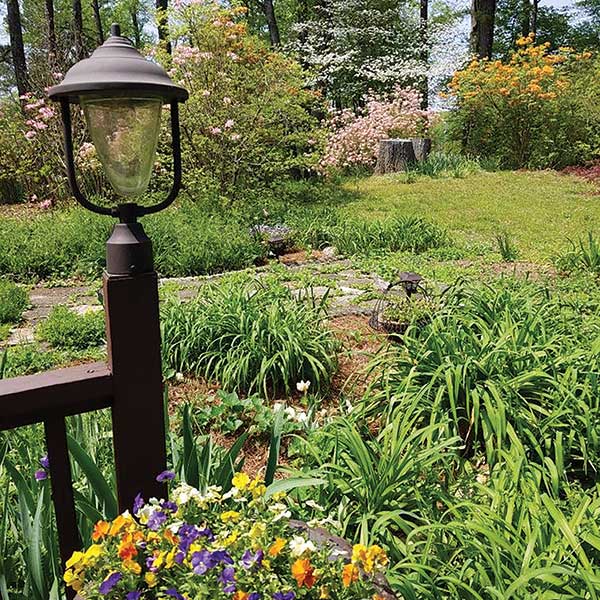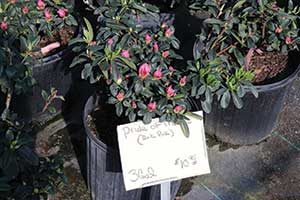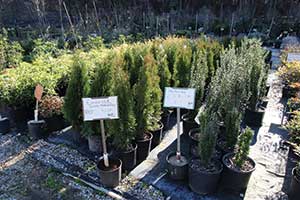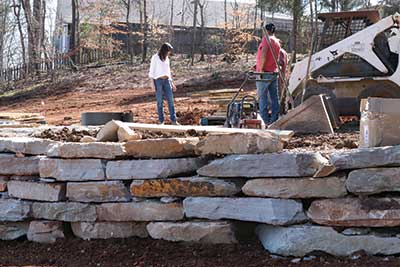Butch and Martha Walker’s amazing property
Story and photos by Joe Whitten
Submitted photos
Southern souls start longing for spring in January, and by February, they check daffodil rows each day to see if they have awakened from winter sleep and begun stretching toward the sun.
Soon, rows of golden joy grace tended yards and old homeplaces where house and barn no longer stand. March and April find trees on Beaver and Bald Rock mountains leafing out and underneath the trees, native azaleas blossom pink and white. Rural folk used to call these azaleas, “mountain honeysuckle” or “bush honeysuckle.”
Azaleas. This springtime glory of the South brings myriad colors through quiet boulevards of old towns and acres of gardens tended by horticulturists. This beauty calls to mind Mobile’s Bellingrath Gardens, 283 miles from Pell City, and Callaway Gardens, 118 miles from Pell City. However, within five miles of the St. Clair County Courthouse in Pell City, Butch and Martha Walker’s unique house sits on reclaimed strip-mine land planted with over 400 azaleas.
Butch’s azaleas and seasonal plants complement the home designed by St. Clair County native Randy Vaughan, who grew up in Eden. After graduating from Pell City High School in 1975, he went to Auburn. “He was studying architecture, and this was his senior class project at Auburn,” Butch recounted. “He graduated No. 1 in his class.”
Since then, Vaughan has enjoyed a successful career as an architect. He noted that he had worked in nearly every scale of architecture, from custom-designed private residences to large-scale projects.
As a student, Vaughan designed a two-level home for the Walkers with the great room, dining room, and kitchen on the lower level and three bedrooms and two baths on the upper level. “We both really liked it when we first saw it,” Martha said, with Butch adding, “We were debating whether to build in front of this strip mine cut or behind it, and Randy decided to put the house on piers and span the cut. Originally, it was open underneath, but later we closed it in and poured a floor.”
Butch and Martha have added two upper-level rooms – a sunroom across the back and a living room across the front. The focal points of the living room are Butch’s grand piano and the arched double doors, which were a serendipitous find. Martha spotted the doors at Mazer’s in Birmingham and told Butch about them.
“I worked just over at O’Neal (Steel),” Butch recalls, “so I went over there at lunch, and they wanted a big price for it. So, I asked the guy if he thought they’d take less. He said, ‘I don’t know, but this guy riding up on the cart can tell you.’ So, he pulled up and I asked him, and he said, ‘Would you pay so-and-so?’ I said, ‘No,’ and I told him how much I’d give. He said, ‘Well, let him have it for that.’ So that’s how we got the doors for about 75% less than he was asking.”
With her eye for color and detail, Martha has made their home a warm and welcoming one for family and friends. Whether it be a Sunday afternoon of music in the living room or a holiday meal at the dining table, guests are made to feel at home.
Back to his roots
Butch had finished college and served in Vietnam when he and Martha Kirkland married in 1974. They lived in two or three different places, but eventually moved into Butch’s parents’ home on Highway 174. Butch and Martha’s property lies not far from his parents’ original 23 acres, where their son, Kirk, lives with his family and enjoys about over 100 azaleas Butch has planted there.
In some of his college work, Butch studied horticulture. When asked how he became interested in native azaleas, he replied, “My cousin in Mobile, Glen Burnham, collected them. He and a friend of his had gone all over the Southeast collecting and hybridizing. He had azaleas at his house, and when they were in bloom, the traffic would be backed up for miles.”
“He had some connection with Bellingrath Gardens, because once when we went down for a visit, he said if he had known we were coming, he could have gotten you in to see the gardens free,” Martha recalled. “Glen Burnham also designed a portion of Disney World’s gardens.”
Early planting
Before he married Martha, Butch had planted his first azaleas on the homeplace where he grew up. When he and Martha moved into their Vaughan-designed home in 1981, Butch pruned back those plants, dug them up, and moved them to the reclaimed strip-mine property. Now over 50 years old, those azaleas still burst into variegated glory every spring.
The annual show of colors traveled much before taking root in Pell City. “I’ve dug them out of the woods, and I’ve bought ’em out of Georgia and Mississippi and south Alabama. And one of my cousins worked for T.R. Miller’s lumber company down in Brewton, Ala., and I have some transplanted from the Brewton area.”
Some of his 400 plants result from Butch’s propagation of azaleas. “I’ve done some by cutting, but I do mostly by seed, and that’s a long, drawn-out process because you’re talking about three or four years from seed to bloom.”
Another way to propagate is tissue culture, which Butch describes briefly. “It’s done under sterile conditions. You take a small piece of the plant – the tissue – and put it in a medium under sterile conditions, and it will start multiplying and keep on multiplying. From one little piece, you can get thousands. You keep dividing it. I’ve never done it cause it’s not something you can do at your kitchen table. I do have some plants from tissue culture that I bought out of Pennsylvania.”
With tissue culture, the resulting azaleas’ blossom color will be exactly like the tissue donor plant. However, seedlings can result in myriad colors depending on how cross pollination has occurred.
“With seedlings, you don’t know what colors you’re gonna get until they bloom. One year, I did some cross pollinating and collected the seeds and planted them in my basement. When seedlings have two leaves, you can transplant them into individual cells. I had done that – had 600 seedlings in cells, and they were up about an inch or more tall. Well, we had a nice warm day, and I thought, ‘I’m gonna set them out and get them a little more light and warmth.’ I did. And out of the 600, I killed 599, but the one that survived was a keeper.” Butch aptly named that azalea, “Walker’s Survivor.” When in full bloom, it caused one friend to say, “It’s a confection, whipped cream and peaches.”
“Some people might say we lead a boring life,” Martha comments, “but we are workers and do a lot of work around here. Our life has been an adventure in hard work.”
One of those adventures came when Butch decided a tree limb needed to go. “Well, this was in 2011. I was walking back to the barn, and this tree limb was hanging out there – and it could have stayed there a hundred years without hurting anything. Well, I looked at it and decided it was time for it to come down. So, I got my ladder and put it on the tree. Got my chainsaw, and I went up and I cut. When it fell, it sprung back, and I fell 15 feet, head down. I held onto the ladder, and that kept me straight and probably kept me from getting badly broken up. I had thrown my saw when I saw what was happening and it landed on the ground still running.
“After I could breathe again, I got up and turned the saw off and came to the house. I turned the fan on and sat in my recliner a few minutes. Then I got in my car and drove over to my neighbor’s, and he drove me to the emergency room over on Hospital Drive in Pell City, and a helicopter took me to Birmingham.”
“They called me at Kennedy School,” Martha added, “and said, ‘Mrs. Walker, you need to leave as soon as possible. Your husband has taken a significant fall.’ I said, ‘What!?’ And they said, ‘We are airlifting him out now, even as we are speaking.’ And I told the school receptionist, ‘Bye. I’m gone!’
Martha could see the helicopter whirling ahead of her as she drove to the hospital. “We finally got to see him and Butch really looked awful. They were trying to pull his arm back in place.”
Fortunately, Butch fared better than Humpty Dumpty did in his garden wall crackup, for the doctors got Butch put back together after a five-hour surgery on his wrist. Butch wore a cast for five weeks, then went to physical therapy.
He asked the therapist if he would be able to play the piano again, and she thought he was pulling the old piano joke: “Doc, will I be able to play the piano?” And the Doc says, “Yes.” And the patient says, “That’s good! I wasn’t able to play it before!”
When Butch convinced her that he indeed played the piano, the therapist said, “That will be good therapy.” So, with short periods at his grand piano, he started playing the Southern gospel songs that he had loved playing all his life.
Some of those old songs may have flitted through Butch’s mind as he fell from the tree – “I’ll Fly Away,” or “Precious Memories,” or “I’m in the Glory Land Way.” However, one of the first ones he played after the fall must have been “Precious Lord Take My Hand,” for Butch and Martha agree that God’s hand was with them during that event and throughout their lives.
After some months, Butch was back to his gardening and propagating azaleas, and from early spring to late autumn, his and Martha’s place is awash in color by blossom and foliage. A place of peace and contentment. Home.




















